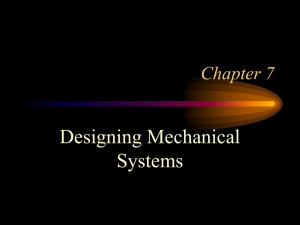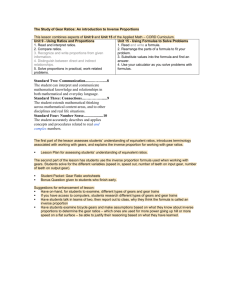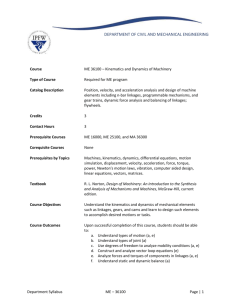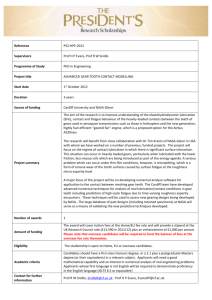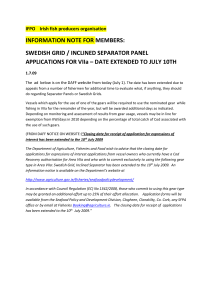MECHANISMS
advertisement
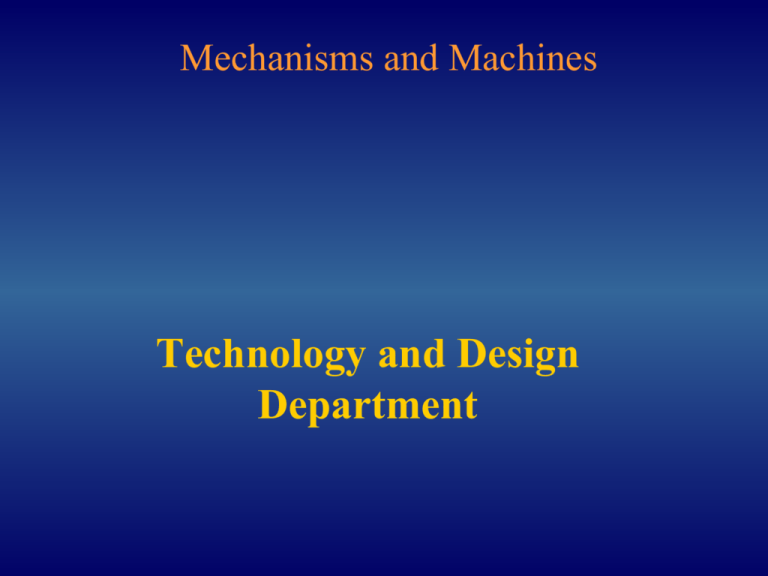
Mechanisms and Machines Technology and Design Department Mechanisms and Machines comes entify different mechanisms and there uses. nalyse the input, control, output of mechanical syste nalyse the motions and forces involved. now about - Mechanical Advantage - Velocity Ratio and Gear Ratio. - Efficiency lculate moments of force. nderstand and calculate Torque. lculate input and output speeds. Mechanisms and Machines Useful Websites www.technologystudent .com www.dtonline.org www.howstuffworks.co m www.ajkids.com Mechanisms and Machines Different types of mechanisms • Levers • Linkages • Gears • Wheels •Cranks and ratchets • Cams • Chain & Sprocket Mechanisms and Machines A mechanism is something that changes an input motion and force into an output motion and force. Mechanisms and Machines A machine is something that uses mechanisms to do useful work. Mechanisms and Machines All kinds of machines make work easier for us by changing the direction or size of the applied force. The amount of force we save by using the machine is called mechanical advantage. Mechanisms and Machines Mechanisms require some type of Motion (movement) There are four types of motion: Linear Rotary Reciprocating Oscillating Mechanisms and Machines Mechanisms are activated by forces. The different types of forces are: Static - no movement (still force) Dynamic - moving forces Compression - squashing force Tension - pulling force Bending - compression and tension Torsion - turning or twisting Shear - cutting Equilibrium - all forces are balanced Mechanisms and Machines Mechanismscan givean advantagewhen lifting a load. Thisadvantageiscalled Mechanical Advantage(MA). It iscalculated asa ratio - MA = LOAD EFFORT Example: a lever usesan effort of 10N to lift a load of 50N. 10N MA = 50N/10N = 5:1 (or just) = 5 Thislever givescan lift 5 timestheeffort. 50N Mechanisms and Machines Efficiency Efficiency is a comparison of the useful work energy provided by a machine or system to the work energy applied to the machine or system. The formula for efficiency is: output/input = work out/work in All the parts of a machine or system and how they are connected together will affect the machine's or system's efficiency. Other forces such as friction will affect an object's movement. Mechanisms and Machines Velocity Ratio(VR) Velocity Ratio(VR) is a comparison of the distance a load moves to the distance travelled by the force needed to move it. VR = Distance moved by the Effort = de Distance moved by the Load dl Example: if a lever moves a load 1.0m by pushing down at the other end by 2.0m, what is the VR? VR = de dl = 2.0m = 2 = 2 1.0m 1 Mechanisms and Machines Levers Technology and Design Department Mechanisms and Machines A lever is a rigid beam that can rotate about a fixed point called the fulcrum. An effort applied to one end of the beam will cause a load to be moved at the other. Effort Load Fulcrum Mechanisms and Machines There are three types(or classes) of lever. Class1. The Fulcrum is in themiddle. example: see-saw Class2. The Load isin the middle. example: wheel barrow Class3. The Effort isin the middle. example: tweezers FLE 123 F-1 L-2 E-3 Mechanisms and Machines Therearethree types(or classes) of lever. Class 2. The Load isin the middle. example: wheelbarrow L F E F-1 L-2 E-3 Mechanisms and Machines There are three types(or classes) of lever. Class3. The Effort isin the middle. example: tweezers This fire extinguisher uses a third-class lever on its handle F-1 L-2 E-3 Mechanisms and Machines Torques cause changes in rotational motion. If an object is at rest, torque exerted on it will cause it to rotate. When you use a lever, you exert a torque on it and the lifting bar rotates about the centre. Mechanisms and Machines There are two forces that can be applied to the see-saw to cause it to rotate. The first force is the weight of person 1 and the second force is the weight of person 2. The torque acting on each end is calculated by taking the weight multiplying by the distance from centre of the see-saw. Mechanisms and Machines To calculate the torque, you need to know : the magnitude of the force, the direction of the force, the distance from the application point of the force to the turning point. t=Fxd When more than one force is involved, the torque is calculated for each separately and then they are added together taking care to include the proper sign. Example: m1 = 1 x d1 = F1d1 m2 = 2 x d2 = F2d2 Mechanisms and Machines Mechanismscan givean advantagewhen lifting a load. Thisadvantageiscalled Mechanical Advantage(MA). It iscalculated asa ratio - MA = LOAD EFFORT Example: a lever usesan effort of 10N to lift a load of 50N. 10N MA = 50N/10N = 5:1 (or just) = 5 Thislever givescan lift 5 timestheeffort. 50N Mechanisms and Machines Linkages Technology and Design Department Mechanisms and Machines A linkage is a mechanism made by connecting together levers. To connect the levers together you can use any type of fastening which allows free movement, for example screws, pins, paper fasteners, pop rivets etc. The linkage can be made to change the direction of a force or make two or more things move at the same time. Mechanisms and Machines Reversemotion linkage input control output Input and output motionsarein oppositedirections. Mechanisms and Machines Push/pull linkage input output control Input and output motion isin the same direction Mechanisms and Machines Parallel motion linkage input output control The sides stay parallel as they move. Mechanisms and Machines Equalising linkage input control Equal outputs from a single input. output output Mechanisms and Machines Bell-crank lever input output control A linear input changes to a rotary output. Mechanisms and Machines ToggleClamp input control The input motion pushes the output block to act as a clamp. output Mechanisms and Machines Gears Technology and Design Department Mechanisms and Machines Gears Gears are toothed or pegged wheels meshed together to transmit motion and force. In any pair of gears the larger one will rotate more slowly than the smaller one, but will rotate with greater force. Each gear in a series reverses the direction of rotation of the previous gear. The Gear Train Gears work in teams. Two gears working together is called a gear train. The gear on the train to which the force is first applied is called the driver. The final gear on the train to which the force is first applied is called the driven gear. Any gears between the driver and the driven gears are called the idlers. Notice the arrows on top of the gears. They are showing that the gears move in different directions. Mechanisms and Machines Meshed Gears The diagram below shows five meshed gears. The first gear that the force is applied is called the driver gear. Notice that the arrows show how the gears are turning. Every other gear is turning clockwise. The very last gear is the driven gear. All of the gears in between are called idlers. Mechanisms and Machines Worm and Wormwheel A gear which has one toothe is called a worm. The tooth is in the form of a screw thread. A wormwheel meshes with the worm. The wormwheel is a helical gear with teeth inclined so that they can engage with the thread-like worm. The wormwheel transmits torque and rotary motion through a right angle. The worm always drives the wormwheel and never the other way round. Worm mechanisms are very quiet running. Mechanisms and Machines Internal gears Internal gears have better load-carrying capacity than external spur gears. They are safer in use because the teeth are guarded. Why Do Clocks Have Brass Gears? Brass gears are often used in clocks where they work well without any lubricant. Oil causes dust to adhere to the gears and this causes gear-tooth wear. An advantage of brass gears is that constant meshing work hardens their teeth. Because of this, the brass gears in well used old clocks often show little sign of wear. Mechanisms and Machines Gears Simple Gear System Simple Gear System with Idler Gear Mechanisms and Machines Compound Gear System More complex 'compound' gear trains can be used to achieve high and low gear ratios in a compact space by coupling large and small cogs on the same axle. Mechanisms and Machines Gear Ratio = Velocity Ratio (VR) driver = 60 teeth driven = 20 teeth VR = the number of teeth on the driven gear = N = 20 = 1 the number of teeth on the driving gear. R 60 3 The velocity ratio of a compound gear train is calculated by multiplying the velocity ratios for all pairs of meshing gears. VR = n X n X n r r r Mechanisms and Machines A rack and pinion mechanism is used to transform rotary motion into linear motion and vice versa Rack and Pinion A single gear, the pinion, meshes with a sliding toothed rack. This combination converts rotary motion to back and forth motion. Windshield wipers in cars are powered by a rack and pinion mechanism. A small pinion at the base of the wiper meshes with a sliding rack below. Mechanisms and Machines Bevel Gears Gears that mesh at an angle change the direction of rotation. Bevel Gears They are used in pairs to transmit rotary motion and torque where the bevel gear shafts are at right angles (90 degrees) to each other Mechanisms and Machines Driven Gear: the output motion and force are transmitted by this gear Driver Gear: the input motion and force is applied to this gear Gear Ratio: the gear ratio is defined as the rotation speed of the output shaft divided by the rotation speed of the input shaft. Gear Train: a group of gears working together; They are arranged so that their teeth closely interlock (mesh). Gear Wheel: a basic mechanism. A gear is a wheel with accurately machined teeth round its edge. Its purpose is to transmit rotary motion and force. Meshed Gears: when the teeth of one gear are engaged with the teeth in the other Spur Gears: two spur gears of different sizes mesh together; The larger gear is called a wheel and the smaller gear is called the pinion. Mechanisms and Machines Cams Technology and Design Department Mechanisms and Machines CAMS, CRANKS AND RATCHETS Mechanisms and Machines A CAM changes rotary motion (circular movement) to linear motion (one that moves in a straight line). They are found in many machines and toys. A CAM has two parts, the FOLLOWER and the CAM PROFILE. Diagrams one to six show a rotating cam pushing a follower up and then allowing it to slowly fall back down. Mechanisms and Machines The cam is used to convert rotary motion to reciprocal motion (backwards and forwards motion) Mechanisms and Machines Cams can be shaped in any number of ways and this is determined by the way the follower is to move. The shape of the cam is called the PROFILE. Examples of various cam profiles can be seen below. Pear Circular/eccentric Pear shaped cams are used on the Circular cams or eccentric shafts of cars. The follower cams produce a smooth remains virtually motionless for motion. These cams are about half of the cycle of the cam used in steam engines. and during the second half it rises and falls. Mechanisms and Machines Heart Heart shaped cams allow the follower to rise and fall with ‘uniform’ velocity. Drop or Snail What type of movement do you think this cam profile will give ? Mechanisms and Machines Different types of follower FLAT POINT/KNIFE ROLLER OFFSET Mechanisms and Machines One cycle = One rotation/revolution of the cam. Fall = That part of the cam that causes the follower to fall. Dwell = When the cam rotates but the follower does not rise or fall. Rise = That part of the cam that causes the follower to rise. Mechanisms and Machines The Flat Plate Cam / Linear Cam: As the flat plate cam profile moves to the left the follower drops down the slope and then eventually rises up at the other end. The flat plate cam then reverses in the opposite direction and the follower drops and rises again. The edge of the flat plate cam can be shaped to give different vertical movements of the cam follower. Flat plate cams or linear cams as they are often called are used frequently in machines which carry out the same repetitive movements. Mechanisms and Machines Mechanisms and Machines QUICK RETURN CRANK MECHANISM A quick return mechanism such as the one seen opposite is used where there is a need to convert rotary motion into reciprocating motion. As the disc rotates the black slide moves forwards and backwards. Many machines have this type of mechanism and in the school workshop the best example is the shaping machine. Mechanisms and Machines The shaping machine is used to machine flat metal surfaces especially where a large amount of metal has to be removed. Other machines such as milling machines are much more expensive and are more suited to removing smaller amounts of metal, very accurately. The reciprocating motion of the mechanism inside the shaping machine can be seen in the diagram. As the disc rotates the top of the machine moves forwards and backwards, pushing a cutting tool. The cutting tool removes the metal from work which is carefully bolted down. Mechanisms and Machines CRANK AND SLIDER MECHANISM This mechanism is composed of three important parts: The crank which is the rotating disc, the slider which slides inside the tube and the connecting rod which joins the parts together. As the slider moves to the right the connecting rod pushes the wheel round for the first 180 degrees of wheel rotation. When the slider begins to move back into the tube, the connecting rod pulls the wheel round to complete the rotation. One of the best examples of a crank and slider mechanism is a steam train. Steam pressure powers the slider mechanism as the connecting rod pushes and pulls the wheel round. The cylinder of an internal combustion engine is another example of a crank and slider mechanism Mechanisms and Machines CRANK AND SLIDER MECHANISM Spark plug intake valve The four "strokes" of these engines are as follows. Intake: The intake valve opens allowing fresh oxygen rich air mixed with fuel to enter the cylinder. Compression: The piston is pushed upward by the flywheel's momentum compressing the air/fuel mix. chamber cylinder Combustion: As the piston reaches the top of its stroke the spark plug fires igniting the mixture. Due to the high compression of this mixture (typically around 190 PSI in a typical engine) it is very volatile and it explodes when the spark is introduced. This pushes the piston downward and produces power. Exhaust: After the Air/Fuel mix has been burnt the remaining chemicals in the cylinder (water and CO2 for the most part) must be removed so that fresh air can be brought in. As the piston goes back up after combustion the exhaust valve opens allowing the exhaust gasses to be expelled. Piston exhaust valve Mechanisms and Machines RATCHET MECHANISMS A ratchet mechanism is based on a wheel that has teeth cut out of it and a pawl that follows as the wheel turns. Studying the diagram you will see that as the ratchet wheel turns and the pawl falls into the 'dip' between the teeth. The ratchet wheel can only turn in one direction - in this case anticlockwise. The water well ratchet mechanism allows the person to rotate the handle in an anticlockwise direction. The bucket of water is heavy and so the person can rest by taking his/her hands away from the handle. This is because the pawl has fallen into the 'dip' between the teeth and so the bucket cannot fall back into the well. Ratchet mechanisms are very useful devices for example, they are used in mechanical clocks. They are also very useful when using a system, such as the one shown, to lift heavy weights. Torque Levers Linkages Pulleys Cranks Ratchets Cams Mechanisms Mechanical Advantage Velocity Ratio Gear Ratio Velocity Moments Force Linkage Bell-crank Simple gear train Worm and worm wheel Internal gears Lubricant Chain and Sprocket Motion Linear Rotary Reciprocating Oscillating Static Load Effort Fulcrum or Pivot Parallel Equalising Toggle Dynamic Compression Tension Bending Torsion Shear Equilibrium Compound gear train Axle Rack and pinion Bevel gears Spur gears Eccentric Rise Dwell Fall Crank and slider Compression Combustion Exhaust


